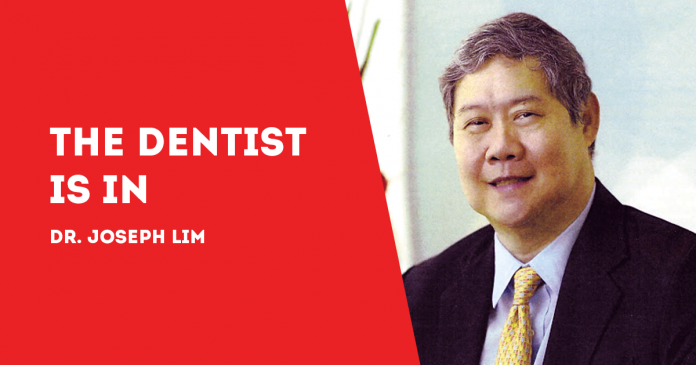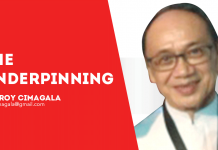
(By Dr. Joseph D. Lim and Dr. Kenneth Lester Lim, BS-MMG, DDM, MSc-OI)
TEETH should be brushed last thing at night or before bedtime.
There is evidence to indicate that brushing at night and not eating thereafter will enable fluoride protection during the night and avoid the retention of carbohydrates in the mouth during sleep time when the salivary flow is low.
It’s one of the recommendations of a study commissioned by the World Dental Federation (FDI or Fédération Dentaire Internationale), the largest association of 200 national dental associations and specialist groups in more than 130 countries with more than 1 million members.
The FDI promotes oral health as a fundamental human right.
The study sought to develop professional consensus on tooth brushing methods and associated behaviors for children, adults, and the elderly based on published evidence, clinical guidelines, and expert professional consensus.
About two billion people worldwide suffer from dental caries or tooth decay in their permanent teeth, the FDI declares. “By implementing effective preventive strategies, there exists a considerable potential to significantly decrease the prevalence of these diseases,” it says.
One of these strategies is toothbrushing. Today, there are several ways to brush your teeth using a variety of tools, from the simple toothbrush to the electric version.
For a long time now, toothbrushing methods have been debated in the oral healthcare community. In response, the FDI commissioned the meticulous review of scientific literature to identify evidence on the effectiveness of different toothbrushing methods and recommended frequencies.
Among the recommendations:
Tooth brushing should be carried out at least twice daily, before bedtime and on at least one other occasion.
This is necessary in order to remove plaque and to maintain a favorable level of fluoride during the daytime.
Maintaining levels of fluoride in the mouth throughout the day and night has been shown to play a major part in the prevention of dental caries.
In populations highly susceptible to tooth decay, additional tooth brushing may be needed, especially in countries that do not add fluoride to the water supply and where the sole source of fluoride exposure is through brushing with a fluoridated toothpaste.
As for the duration of brushing, teeth should be brushed long enough to ensure that all surfaces are cleaned effectively. Ensuring that all surfaces are cleaned is more important than adhering to a specific duration of brushing.
The effectiveness of manual and electric-powered toothbrushes is influenced by user technique, and so dental professionals should ensure that patients are taught to brush thoroughly and clean all surfaces and gums. For people with periodontitis, a severe form of gum disease, particular attention should be given to the gumline.
Tooth brushing should be supervised by a parent or carer until a child is able to brush their own teeth effectively, thereby creating a lasting competency in tooth brushing behavior.
The ability to brush effectively will differ from one child to another, and so the appropriate age to stop supervised tooth brushing should be determined by the child’s parent or carer.
Using either a soft toothbrush or cloth, teeth should be brushed/cleaned as soon as the first tooth appears. Cleaning with a soft toothbrush should be prioritized over cleaning with a cloth whenever possible.
Rinsing with water or a mouth rinse after brushing can have the undesirable effect of removing all traces of fluoride toothpaste from the oral cavity. However, rinsing with a minimal amount of water or mouthwash may be beneficial for some who have difficulties with manual dexterity and brushing techniques.
Several recommendations raise financial considerations. For instance, the use of toothpastes with different fluoride concentrations from infant through to adolescent may be recommended. However, the cost of purchasing several toothpastes of different concentrations for different family members may be prohibitive.
For some families, it may be more appropriate to focus on using a smaller amount of a family toothpaste rather than purchasing several different products.
The evidence suggests that electric toothbrushes are more effective than the manual versions in reducing plaque and gingivitis. However, the initial and ongoing costs may be unaffordable to many, possibly increasing oral health disparities.
In that case, the old reliable, the manual toothbrush, is just as good.
***
Dr. Joseph D. Lim, Ed. D., is the former Associate Dean of the College of Dentistry, University of the East; former Dean, College of Dentistry, National University; Past President and Honorary Fellow of the Asian Oral Implant Academy; Honorary Fellow of the Japan College of Oral Implantologists; Honorary Life Member of the Thai Association of Dental Implantology; and Founding Chairman of the Philippine College of Oral Implantologists. For questions on dental health, e-mail jdlim2008@gmail.com or text 0917-8591515.
***
Dr. Kenneth Lester Lim, BS-MMG, DDM, MSc-OI, graduated Doctor of Dental Medicine, University of the Philippines, College of Dentistry, Manila, 2011; Bachelor of Science in Marketing Management, De la Salle University, Manila, 2002; and Master of Science (MSc.) in Oral Implantology, Goethe University, Frankfurt, Germany, 2019. He is an Associate Professor; Fellow, International Congress of Oral Implantologists; Member, American Academy of Implant Dentistry and Fellow, Philippine College of Oral Implantologists. For questions on dental health, e-mail limdentalcenter@gmail.com./PN




